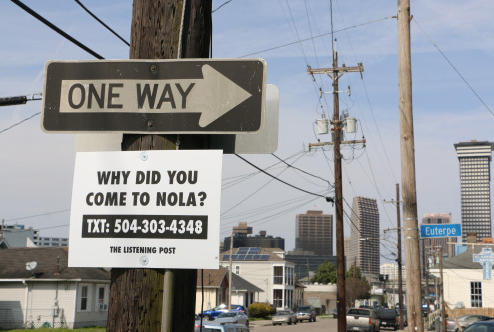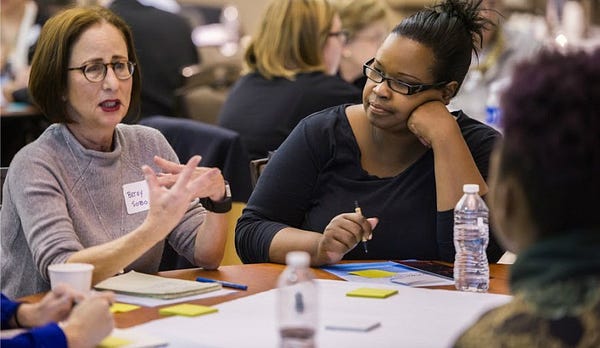“A good newspaper, I suppose, is a nation talking to itself.” — Arthur Miller
At a panel on “The Hunt for News Products of the Future” hosted by CUNY and the New School last week, Aron Pilhofer, the Interim Chief Digital Officer of The Guardian, said he is fascinated with the intersection of messaging, bots and artificial intelligence in apps like Facebook’s project M, and how that might change how we enter into a conversation with the news. The comment came on the heels of Pilhofer discussing the new mobile app from Quartz, which uses a messaging interface to deliver news via interactions with the user. He said using the Quartz app was “the first time I opened up a news app and felt like it had a soul.”

I felt that too — perhaps not a soul, but a sense of connection.
In their launch post, Quartz’s Zach Seward described the app as “an ongoing conversation about the news, sort of like texting: We’ll send you messages, photos, GIFs, and links, and you can tap to respond when you’re interested in learning more about a topic.” The back and forth feels natural and engaging, I found myself wanting to keep reading to find out what was next. All the updates are written by humans, the interactions are designed by people, and it feels that way.
I think people are hungry for this kind of conversation and connection with the news. They want that intimacy, that curiosity, that sense that not only does the news organization know you, but the journalists there want to help you. We see this in the popularity of formats like Reddit’s AMA’s, Digg’s new Dialog project and in research like this, which found that when journalists engage with their community on Twitter it enhances journalists’ credibility.However, we also see this in the rise in popularity of journalism events and community engagement efforts.
Quartz isn’t the only one experimenting with messaging and conversation around the news. In April 2015 BuzzFeed launched on messaging app Kik, allowing people to customize the news they received via keywords in messages. Other publishers have experimented with Facebook Messenger, Line and WhatsApp.

The Listening Post in New Orleans is using mobile messaging app Groundsource to have robust conversations with their community that become the building blocks for news programming on the local public radio station. Jersey Shore Hurricane News calls itself a two-way news source, where stories are interwoven with feedback and participation from its more than 220,000 Facebook fans. Across the country, newsrooms using the Hearken platform are responding to the questions and curiosity of local residents in amazing ways. ProPublica has used Facebook not only to listen before a story but also to extend the conversation and support the community long after a story is published.
At the Local News Lab, a project of the Geraldine R. Dodge Foundation, we are supporting many of the organizations and projects listed above because we believe that bringing the public in conversation with journalists will not only create better news, but also foster stronger communities (if you are interested, we just released a report on how these efforts are going). In 2012 Jonathan Stray wrote about the need for both software and processes that could help journalists be better moderators and facilitator of community conversations: “I see the solution journalist as responsible for the process of public discussion by which problems are defined and turned into plans for the future.” He continued later in his post:
“So there is software, and there is process, and there are people bound up together who will see different aspects of their shared condition. Sometimes they will disagree violently about the truest representation and the worthiest goal. Perhaps the work of solution journalism is not to propose solutions, but to help a community come to a shared understanding of what its major problems are, which is the first and possibly hardest step in solving them.”

There is a huge gulf between facilitating large scale civic discussions and creating interactive chat apps that deliver the news to people staring at their phones, but I’m encouraged nonetheless by the ways in which conversation is increasingly being seen as part of journalism.I’m not arguing that any one app will rebuild the public square. But research and design initiatives like the Coral Project and the Engaging News Project, and engagement projects like Hearken and the Listening Post, are beginning to make important strides in how we think about connecting media, technology and communities.
In 1961 the playwright Arthur Miller said, “A good newspaper, I suppose, is a nation talking to itself.” But as journalist and activist Jose Antonio Vargasrecent noted in an interview about diversity in American newsrooms, we are far from hearing the full range of voices in our nation. At a time of immense polarization and incredible social, economic and environmental challenges, we desperately need new ways for our nation to talk to itself. The political philosopher Danielle Allen wrote in her 2004 book Talking to Strangers, “As for distrust of one’s fellow citizens, when this pervades democratic relations, it paralyzes democracy.[…] Democracy depends on trustful talk among strangers and, properly conducted, should dissolve any divisions that block it.”
Journalists can help us begin to envision each other as “democratic strangers” instead of distant others, they can welcome us into difficult conversations, and create space for “trustful talk.”
News apps come and go, and while Quartz’s app crystalizes a certain idea about news as a conversation, I see it as part of a larger trend. Each creative experiment that encourages people to interact with the news in new ways, and forces newsrooms to think differently about how they serve communities is a step in the right direction.
Josh Stearns is the Director of Journalism & Sustainability at the Geraldine R. Dodge Foundation, where he and Molly de Aguiar run the Local News Lab. Follow him on Twitter and subscribe to the Local Fix newsletter for a weekly round-up of links to the best thinking about community engagement, innovation and new business models for news.

Very interesting read. Hope to hear more soon.
Hi Josh! We featured your blog and posts like this one in our list of best media blogs of 2016. Check it out here: https://postal2016.wordpress.com/2016/03/22/the-postal-awards-top-5-media-blogs-of-2016/.
Thanks for sharing my work.